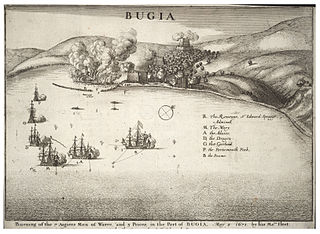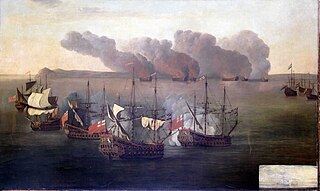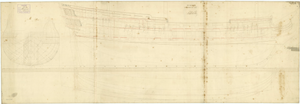
HMS Cornwall was an 80-gun, third rate, ship of the line built for the Royal Navy in the 1690s. She served in the War of the Grand Alliance, and in her first year took part in the Battle of Barfleur and the action at La Hougue.

HMS Cornwall was a 74-gun third-rate Vengeur-class ship of the line built for the Royal Navy in the 1810s. She spent most of her service in reserve and was converted into a reformatory and a school ship in her later years. The ship was broken up in 1875.
HMS Northumberland was a 70-gun third-rate ship of the line of the Royal Navy, built by Francis Bayley of Bristol in 1677/79. She partook in the last great battle of the War of English Succession and the first battle of the War of Spanish Succession. She was lost in the Great Storm of November 1703.
HMS Rupert was a 64-gun third rate ship of the line of the Royal Navy, launched at Harwich Dockyard on 26 January 1666 and broken up in 1769.

HMS Oxford was a 54-gun fourth-rate ship of the line of the Royal Navy, built by Francis Baylie in Bristol and launched in June 1674. Her guns comprised twenty-two 24-pounders on the lower deck, with twenty-two large sakers (8-pounders) on the upper deck and ten smaller sakers (5-pounders) on the quarterdeck.
HMS Reserve was one of six 40-gun fourth-rate frigates, built for the Commonwealth of England under the 1650 Programme, after the Restoration of the monarchy in 1660 she was incorporated into the navy of the Kingdom of England. She partook in no major Fleet actions during the First Anglo-Dutch War. After the Restoration during the Second Anglo-Dutch War she partook in the Battle of Lowestoft, the Four Days' Battle and the St James Day Battle. She spent the bulk of her service either in the Mediterranean or at Newfoundland. She foundered off Yarmouth in November 1703.

Advice was one of six 40-gun fourth-rate frigates, built for the Commonwealth of England under the 1650 Programme, she would be transferred to the navy of the Kingdom of England upon the Restoration of the monarchy in May 1660. During her time with the Commonwealth Navy she would fight in two major fleet engagements of the First Anglo-Dutch War, this being the Battle of Portland and the Battle of the Gabbard. After the Restoration she would be involved in the Second Anglo-Dutch War specifically the Battle of Lowestoft and the St James Day Battle. She would also be present at the attack on the Vile or better known as Holmes Bonfire. She would see action against the Algerines at the Battle of Bugia. During the Third Anglo-Dutch War she would do battle at the Battle of Solebay, The Battle of Schooneveld and the Battle of Texel. She would also do battle against the French at the Battle of Bantry Bay. She would see service in both the West and East Indies before being rebuilt at Woolwich.

HMS Centurion was one of six 40-gun fourth-rate frigates, built for the Commonwealth of England under the 1650 Programme, she would be transferred to the navy of the Kingdom of England upon the Restoration of the monarchy in May 1660. When commissioned she partook in the First Anglo-Dutch War. After the first war ended she was in the Mediterranean fighting the Algerines at the Battle of Santa Cruz. She fought the battles of Dover, Portland, the Gabbard, and Scheveningen. During the Second Anglo-Dutch War she partook in the battles of Lowestoft and Orfordness. Following the second war she spent her time either in North America or the Mediterranean. She was wrecked in a storm in December 1689.
HMS Assistance was one of six 40-gun fourth-rate frigates, built for the Commonwealth of England under the 1650 Programme, after the Restoration of the monarchy in 1660 she was incorporated into the navy of the Kingdom of England. During her time in the Commonwealth Navy she partook in the First Anglo-Dutch war being present in the battles of Kentish Knock, Portland and The Gabbard. In the Mediterranean she was present at the Battle of Santa Cruz and the bombardment of Porto Farina, In the Second Anglo-Dutch War she was involved in the Battle of Lowestoft, Battle of Vagen and the St James Day Fight. She did not participate in fleet actions after this. She spent the rest of her service life undergoing several rebuilds and plying the waters as a cruiser protecting British trade and projecting British sovereignty. After nearly 95 years of Service she was sunk as a break water at Sheerness at the end of 1745.

HMS Captain was a 70-gun third rate built at Woolwich Dockyard in 1677/78. After sitting in Ordinary for ten years she was in active commission for the War of the English Succession fighting at Beachy Head and Barfleur. She was in Ordinary until 1706 when she was rebuilt. She was in active commission for the last half of the War of Spanish Succession but fought in no major engagements. She was at the Battle of Passero I 1718. She was rebuilt in 1720/22. She made two forays in to the Baltic though the bulk of her late career was spent as guardship at Portsmouth. She was hulked in 1740 and finally broken in 1762.

HMS Hampton Court was a 70-gun third rate ship of the line of the Royal Navy, launched at Deptford Dockyard in 1678. Her initial commission was to move her to Chatham where she spent in the next ten years in Ordinary. She held an active commission for the War of the English Succession, participating in the Battles of Beachy Head and Barfleur. She was rebuilt at Blackwall in 1699/1701. During the War of Spanish Succession she served mainly in the Mediterranean. In 1707 she was taken by the French and incorporated into the French Navy for four years. She was sold to the Spanish in 1712. She was wrecked in Spanish service off the coast of Florida in a hurricane in 1715.

HMS Lenox was a 70-gun third rate built at Deptford Dockyard in 1677/78. She was in active commission for the War of English Succession fighting in the Battles of Beachy Head and Barfleur. She was rebuilt in 1699. Again in active commission for the War of Spanish Succession fighting in the Capture of Gibraltar and the Battle of Velez Malaga. She followed this with the Battle off Passero. She was rebuilt again in 1721. She was active in the War with Spain, capturing the Princesa then serving in Home Waters, the Mediterranean and finally the West Indies. She was in action off Havana in 1745. She returned home and was placed in Ordinary. She was finally sunk as a breakwater at Sheerness in 1756.
HMS Pendennis was a 70-gun third rate ship of the line of the Kingdom of England built at Chatham in 1677/79. She was in the War of English Succession. She was in the Battle of Bantry Bay. She was wrecked on the Kentish Knock in October 1689.
HMS Exeter was a 70-gun third rate ship of the line of the Kingdom of England, built by contract Sir Henry Johnson at Blackwall under the 1677 Construction Programme. She was at the Battle of Beachy Head in 1690. She was accidentally burnt at Plymouth in 1691. Her remains were hulked at Portsmouth until she was broken in 1717.

HMS Suffolk was a 70-gun third-rate ship of the line of the Royal Navy, built by contract of 20 February 1678 by Sir Henry Johnson at Blackwall. She participated in the War of the English Succession 1689 - 1697, in the Battles of Beachy Head and Barfleur. She was rebuilt in 1699. She was actively involved in the War of Spanish Succession 1702 - 1713. Her later career was as guard ship duties, deployments to the Baltic Sea and the West Indies. She was finally broken in 1765 after lying in Ordinary for almost twenty years.

HMS Orford was a 70-gun third-rate ship of the line of the Royal Navy, launched at Deptford in 1698. She carried twenty-two 24-pounder guns and four (18-pounder) culverins on the lower deck; twenty-six 12-pounder guns on the upper deck; fourteen (5-pounder) sakers on the quarterdeck and forecastle; and four 3-pounder guns on the poop or roundhouse.
HMS Falmouth was a 50-gun fourth-rate ship of the line built for the Royal Navy in the first decade of the 18th century. The ship participated in several battles during the War of the Spanish Succession (1701–15) and the War of Jenkins' Ear (1739–48).

The 1745 Establishment was the third and final formal establishment of dimensions for ships to be built for the Royal Navy. It completely superseded the previous 1719 Establishment, which had subsequently been modified in 1733 and again in 1741. Although partially intended to correct the problems of the ships built to the earlier Establishments, the ships of the 1745 Establishment proved just as unsatisfactory, and important changes in the make-up of the Admiralty and Navy Boards finally led to the end of the establishment era by around 1751.
HMS Falmouth was a 50-gun fourth rate ship of the line built for the Royal Navy during the 1750s. She participated in the Seven Years' War and was badly damaged during the Battle of Manila in 1762 and was abandoned as unseaworthy in the East Indies in 1765.
HMS Fowey was a 32-gun fifth rate built by Mr. Flint of Plymouth in 1695/96. She was employed in trade protection and counter-piracy patrols in Home Waters and North America. She was in on the capture of a 50-gun Frenchman while returning from Virginia. She was taken by the French off the Scilly Islands in August 1704.










